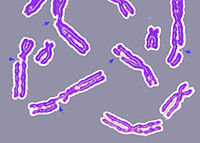
Photo from wikipedia
DNA damage is a common phenomenon promoted through a variety of exogenous and endogenous factors. The DNA damage response (DDR) pathway involves a wide range of proteins, and as was… Click to show full abstract
DNA damage is a common phenomenon promoted through a variety of exogenous and endogenous factors. The DNA damage response (DDR) pathway involves a wide range of proteins, and as was indicated, small noncoding RNAs (sncRNAs). These are double-strand break-induced RNAs (diRNAs) and DNA damage response small RNA (DDRNA). Moreover, RNA binding proteins (RBPs) and RNA modifications have also been identified to modulate diRNA and DDRNA function in the DDR process. Several theories have been formulated regarding the synthesis and function of these sncRNAs during DNA repair; nevertheless, these pathways’ molecular details remain unclear. Here, we review the current knowledge regarding the mechanisms of diRNA and DDRNA biosynthesis and discuss the role of sncRNAs in maintaining genome stability.
Journal Title: International Journal of Molecular Sciences
Year Published: 2020
Link to full text (if available)
Share on Social Media: Sign Up to like & get
recommendations!